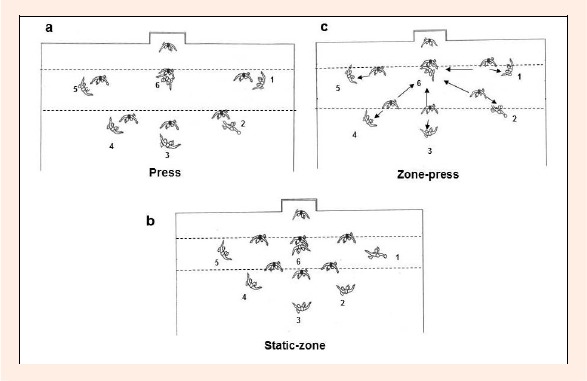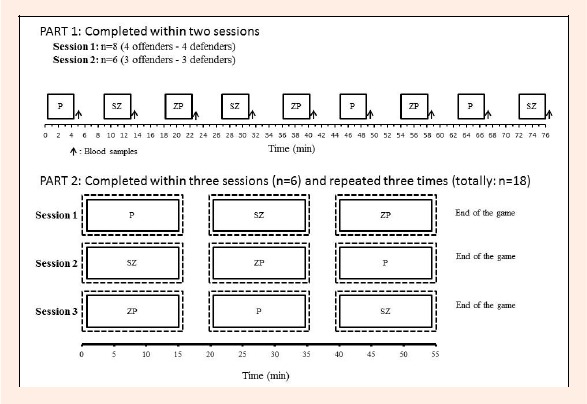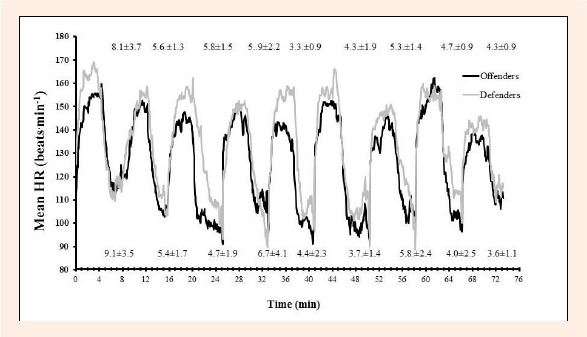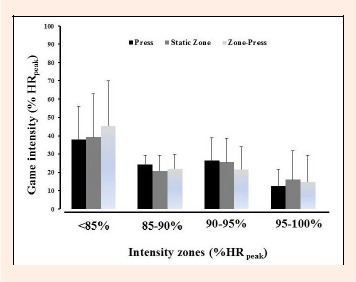Abstract
The aim of this study was to investigate the effect of defense tactical strategy on physiological responses characterizing playing intensity in water-polo game. In the first part of the study, fourteen players were assigned to defending (n = 7) and offending (n = 7) groups and participated in nine 4-min plays applying three different defending systems: press, static-zone and zone-press, in front of the defense court of one goalpost. In the second part, 18 players participated in nine different real full court water-polo games consisting of 3X15min of live-time playing periods. Both in defense court plays and real games, the three defense systems were played in a counterbalanced order and heart rate (HR) was continuously recorded. Additionally, in defense court plays, blood lactate concentration (La) was measured at the end of each 4-min period. Mean HR within defense court plays was higher in press (153 ± 10 beats.min-1) than in static-zone (140 ± 11 beats.min-1) and zone-press (143 ± 16 beats.min-1, p < 0.01). Furthermore, shorter amount of playing time was spent with HR ≤85% of HR peak in press (46.3 ± 22.8%) than in static-zone (81.8 ± 20.5%) and zone-press (75.7 ± 32.0%, p < 0.01). Likewise, mean La was higher in press (6.5±2.9 mmol.l-1) than in static-zone (4.7 ± 2.5 mmol.l-1) and zone-press (4.6 ± 1.8 mmol.l-1, p < 0.01). In real games, however, mean HR was similar between tactical strategies (p > 0.05). Defenders and offenders showed similar HR and La responses across the tactical modes. In conclusion, defense tactical strategies affect physiological responses within a part of the game but do not affect the overall playing intensity of a real water-polo game. Tactical strategies similarly affect offenders and defenders.
Key points.
Within defence court plays, exercise intensity in press is higher than zone-press and static zone tactical systems.
In real game the physiological response is similar between defense systems.
Tactical strategies similarly affect offenders and defenders.
Key words: Team-sports, tactical systems, game demands
Introduction
Several studies have demonstrated that the mean heart rate (HR) during a water-polo game corresponds to lactate threshold intensity and that 58-85% of the real game time is played at intensity higher than 85% of peak HR (Pinnington et al., 1988; Platanou and Geladas, 2006). A number of variables such as the competition level (Lupo et al., 2010), the margin of victory (Lupo et al., 2012a; 2014b), the starting quarter game (Gomez et al., 2014a; 2014b) and the match outcome (Lupo et al., 2011) may affect the activity patterns and/or the physiological responses of players in competition. However, in research related to water polo, it has been overlooked that one of the main reasons that could affect the playing intensity throughout a game is the defense tactical strategy. Recent studies have showed that during a competitive match-play press defensive strategy is the most often applying in the winning teams ( Lupo et al., 2012a; 2014b). Due to the scarce scientific data related to the physiological responses induced by different tactical strategies in water-polo, the reference to land-based team-sports characterized by comparable physiological demands but different court dimensions may be used. In soccer for instance, it has been shown that tactical strategies might be a critical factor determining the physiological loading imposed on players (Bradley et al., 2011; Gerisch et al., 1988; Ngo et al., 2012). Hence, coaches should consider that defense tactical systems might induce different physiological responses when athletes are defending and as such, may affect the total game intensity. So far, the studies investigating the effect of defense tactical strategy on team-game’s demands have shown controversial results. In soccer for instance, it was found that pressing induces higher lactate concentration and increased heart rate than zone coverage (Gerisch et al., 1988; Ngo et al., 2012). Nonetheless, it has been observed that pressing and zone coverage impose similar HR responses and blood lactate concentration throughout basketball games (Ben Abdelkrim et al., 2010).
Three different defense systems could be applied in water-polo: press, static-zone and zone-press. The main characteristic of press is the continuous pressing against the opponent while moving close to him/her. In static-zone, the defenders play zone in front of their area in order to prevent passes to centre-forward. In zone-press, the defender plays pressing when the ball is close to him/her, or zone when the ball is far from him/her, trying to cover the area in front of the centre-forward (Lupo et al., 2012a; 2012b; 2014b).
Defending tactical actions mostly occur in front of the defending area of the court. These actions in turn may affect the overall game physiological responses. To date, it is unknown whether the abovementioned defense actions impose different physiological responses on players, when a defense tactical system is applied in the defense court. Moreover, the effect of defense tactical system on average physiological response during a real water-polo game remains to be identified. The overall intensity of a real game may be different compared to plays performed in front of the defense court, because of adjustment in intensity of several combinations of swimming or playing actions, taking place in the transition period from one defense court to the other, as in a full-court game.
Along these lines, the influence of the applied tactical system on the opponents’ physiological responses playing offence is still unclear. Therefore, the purpose of the present study was to examine whether playing intensity in the defense court differs between tactical systems and also to examine whether the average physiological responses of a real game is influenced by the tactical systems. In addition, we investigated whether defenders and offenders exhibit similar lactate concentration and heart rate responses to different defense tactical systems. We hypothesized that pressing is more demanding than zone-press or static-zone coverage and that defenders and offenders would present similar physiological responses across different defense tactical systems.
Methods
In the first part of the study, fourteen national level male outfield water-polo players (age: 23 ± 6 years, stature: 1.78 ± 0.05 m, body mass: 77 ± 6 kg) participated in defense court plays. In the second part of the study, 18 players (age: 19 ± 3 years, stature: 1.80 ± 0.05 m, body mass: 76 ± 10 kg) participated in real game. The participants were members of the two leading water-polo clubs of Division II Greek National Championship. Both clubs contested for accession in the highest (Division I) Greek National Championship. All participants provided informed consent to participate in this study that was approved by the faculty review board and conformed to the declaration of Helsinki. All games were played during the precompetitive period.
In part 1, we intended to isolate the effect of defense tactical systems per se on blood lactate concentration and HR responses within defense court plays. In part 2, HR was recorded in a real game (full-court, two goal-posts) to examine whether different defense tactical systems affect the total game intensity. Participants’ peak HR was assessed in a maximal intensity freestyle swimming test (4X50 m, rest: 10 s) applied a week before starting each part of the study.
The players positioning for the defending systems applied in both parts of the study (press, static-zone, zone-press) are depicted on Figure 1. In press defending system (Figure 1a), the defenders were positioned at facing of a single offensive player. In static-zone (Figure 1b), the area in front of the center-forward is well-marked and the defenders were positioned close to the goal and try to block the shots performed by the corresponding offensive players. In zone-press (Figure 1c), the defending players in zones 1, 2, 3, 4, positioned according to offending players of the right extreme side, right, central and left side of the perimeter. These players, apply zone to doubly-mark the offensive center forward when the ball is far from them and press when the opponent offensive player posses the ball. The defending player positioned in the left extreme side (zone 5) plays systematically press.
Figure 1.

A graphic representation of press (a), static-zone (b) and zone-press (c) defensive arrangements applied both during defense court plays and real games.
Defense court plays (part 1)
The participants were split equally to two groups (7 defenders and 7 offenders) and participated in two separate experimental sessions, performed in front of the defense court (one goalpost). Data from eight players (4 defenders - 4 offenders) and from six players (3 defenders – 3 offenders) were collected in the first and second sessions respectively. Each experimental session consisted of nine 4-min live-time plays. Each 4-min playing time was interspersed with 5 min of passive rest. The order of playing the defending systems was counterbalanced and data collected at each session and at each play were pooled for the subsequent statistical analysis. The experimental protocol is presented in Figure 2. It was pre-arranged that the selected players would participate in the entire session and not be substituted. Each session was started and completed in even situation and data from two centre-defenders, two center-forwards and ten wings were collected and analyzed.
Figure 2.

The protocol overview of the study applied in two sessions for the first part (n=14) and in nine sessions for the second part of the study (n = 18).
Throughout the sessions, HR of both defenders and offenders was continuously recorded at 5 s intervals and stored for subsequent analysis (Hosand Aqua, Canada). Fingertip blood samples were taken at the first minute of recovery after each 4-min play (n = 8, four defenders and four offenders). Blood sampling at the same time point of the recovery period for each player, required the use of four lactate analyzers, one for each pair of players. Totally, nine blood samples were obtained from each player and samples of each defense system play were pooled for statistical analysis. Blood samples were analyzed for blood lactate concentration using the reflectance photometry enzymatic reaction method (Accusport, Boehringer, Germany).
Real game (part 2)
In the second part of the study, the players participated in a series of three different real game sessions (4-5 days apart), each consisted of three 15-min periods of live-time plays, interspersed with 5 min of passive rest. The real game series was repeated three times and six players were measured in each one of the series. With this experimental design the total number of players tested, was eighteen (n = 18). In each real game, the order of applying the defending systems was counterbalanced (Figure 2). It was pre-arranged that the selected players would play against the same opponent the entire game and not be substituted. Throughout the games, HR was telemetrically recorded for six players in each game (Hosand, Aqua, Canada).
Statistical analysis
All results are expressed as mean ± standard deviations and 95% confidence limits (CL) were also calculated. One-way analysis of variance (ANOVA) for dependent samples on repeated measures was used to detect differences in HR and blood lactate among the tactical systems. Two-way ANOVA for independent samples (defenders and offenders) with repeated measures was performed to compare mean values of HR and blood lactate in the three different defense systems. A Tukey post-hoc test was employed to assign specific differences. As a measure of effect size the Cohen’s d was calculated and values of 0.20, 0.50 and above 0.80 were considered as small, medium and large, respectively.Significance level was set at p ≤ 0.05.
Results
The peak HR of players in part 1 was 187 ± 10 beats.min-1. Within the defense court plays, independent of defending or offending playing position, mean HR was higher by 13 and 10 beats.min-1 after press compared to static-zone and zone-press respectively (p < 0.01, Table 1). In both static-zone and zone-press, all players spent longer time, compared to press, at HR level below or equal to 85% HR peak (p < 0.01, Table 1). No differences were found between static-zone and zone-press in this parameter (p = 0.67). Likewise, lower mean blood lactate values were exhibited in static-zone and zone-press compared to press (p < 0.01, Table 1).
Table 1.
Exercise intensity during real water-polo games and plays performed in front of defense court after press (P), static-zone (SZ) and zone-press (ZP). The intensity is expressed by heart rate (HR), the percentage time spent below 85% of HR peak and lactate values. Data are means (±SD).
| P | SZ | ZP | 95% CL (P) |
95% CL (SZ) | 95% CL (ZP) |
ES (P-SZ) |
ES (P-ZP) |
ES (SZ-ZP) |
|
|---|---|---|---|---|---|---|---|---|---|
| Real Games | |||||||||
| HR (beats.min-1) | 164 (8) | 163 (10) | 161 (13) | 159, 167 | 158, 167 | 154, 167 | .11 | .29 | .19 |
| Percentage time ≤ 85% HR peak (%) | 38.0 (18.1) | 39.3 (23.8) | 45.5 (24.5) | 29.0, 47.0 | 27.5, 51.1 | 32.3, 57.7 | .06 | .34 | .26 |
| Defense court games | |||||||||
| HR (beats.min-1) | 153 (10) | 140 (11) * | 143 (16) * | 147, 158 | 133, 146 | 134, 152 | 1.27 | .82 | .22 |
| Percentage time ≤ 85% HRpeak (%) | 46.3 (22.8) | 81.8 (20.5) * | 75.7 (32.0) * | 32.5, 60.1 | 69.4, 94.1 | 56.9, 94.5 | 1.64 | 1.07 | .23 |
| Lactate (mmol.l-1) | 6.5 (2.9) | 4.7 (2.5) * | 4.6 (1.8) * | 5.2, 7.7 | 3.6, 5.8 | 3.8, 5.4 | .65 | .80 | .05 |
ES: effect size, 95% CL: 95% confidence limits
*p<0.01 from P.
Regarding the opponents’ physiological responses, no differences were shown between offenders and defenders in mean HR (p = 0.33, ES: 0.09-0.49, Figure 3, Table 2), in the amount of playing time spent below 85% of peak HR (p = 0.53, ES: 0.09-0.49) and in blood lactate concentration (p = 0.99, ES: 0.04-0.18) across the different tactical systems.
Figure 3.

Mean heart rate responses recorded every 5 seconds and mean blood lactate concentration of defenders (upper values, n = 7) and offenders (bottom values, n = 7) throughout the defense court plays. Standard deviation has been omitted for clarity.
Table 2.
Exercise intensity during water-polo plays performed in front of defense court for defenders (Def) and offenders (Off) playing press (P), static-zone (SZ) and zone-press (ZP).The intensity is expressed by heart rate (HR), the percentage time spent below 85% of HR peak and lactate values. Data are means (±SD).
| P | 95%CL | SZ | 95% CL | ZP | 95% CL | |
|---|---|---|---|---|---|---|
| Mean HR (beats·min-1) (Def) | 155 (12) | 147, 163 | 141 (13) | 132, 151 | 147 (19) | 135, 160 |
| Mean HR (beats·min-1) (Off) | 150 (7) | 143, 158 | 138 (10) | 129, 147 | 138 (11) | 125, 151 |
| Percentage time ≤ 85% HRpeak -Def (%) | 45.1 (19.1) | 25.6, 64.7 | 79.7 (21.5) | 62.2, 97.1 | 68.0 (36.5) | 41.4, 94.6 |
| Percentage time ≤ 85% HRpeak -Off (%) | 47.4 (27.6) | 27.9, 66.9 | 83.9 (20.9) | 66.5, 101.4 | 83.5 (27.4) | 56.9, 110.1 |
| Lactate (mmol.l-1) (Def) | 6.5 (2.6) | 4.7, 8.4 | 4.5 (2.0) | 2.9, 6.1 | 4.7 (1.1) | 3.6, 5.9 |
| Lactate (mmol.l-1) (Off) | 6.4 (3.2) | 4.6, 8.2 | 4.9 (3.0) | 3.3, 6.5 | 4.5 (2.3) | 3.3, 5.6 |
CL: 95% confidence limits
The peak HR of players participated in real games was 190 ± 8 beats·min-1. Within real games, the three different systems induced similar mean HR (press: 164 ± 8 beats.min-1, 95%CL: 159-168 beats.min-1, static-zone: 163 ± 10, 95%CL: 158-167 beats.min-1, zone-press: 161 ± 13 beats.min-1, 95%CL: 154-167 beats.min-1, p = 0.33). Likewise, no differences between systems in the mean percentage of playing time spent, below or equal to 85% (p = 0.32), between 85-90% (p = 0.14), between 90-95% (p = 0.26), and between 95-100% of peak HR were observed (p = 0.39, Figure 4).
Figure 4.

Average game time spent at different intensities, expressed as percent of peak heart rate (HR peak), across different defence systems during real game.
Discussion
The present study presents a detailed investigation of the influence of the defense tactical strategies on physiological responses of water-polo players. We demonstrated that press is more demanding compared to static-zone and zone-press defending system during defense court plays. This was observed both in defending and offending players. Interestingly, the difference that was exhibited in defense court plays was not apparent during real full-court games, indicating that the defending tactical strategies may have a transient effect on the overall full-court water-polo match intensity.
During a water-polo game the defending tactical strategies are mostly adapted to the opponent’s level as well as to the game conditions and may change in the progress of the game. We hypothesized that press is more demanding than zone coverage. The present findings suggest that although the press system induces higher responses and La concentration than zone coverage in defense court plays, this was not observed in high-competitive real games, where players demonstrated similar HR response across the tactical systems. The observed HR response in the present real games and defense court plays is slightly higher compared to previous reports (Platanou and Geladas, 2006), but similar to that demonstrated by Pinnington et al. (1988) in high-competitive water-polo matches. Likewise, during defense court plays, the mean HR and lactate concentration values were almost similar to values observed in previous studies (Melchiorri et al., 2010; Platanou and Geladas, 2006), suggesting that the overall playing intensity was high enough to reproduce the intensity observed in a “real” game situation. This information should be considered for training applications (i.e. designing game-specific training intensity with defense court plays).
The overall game intensity of a water-polo game seems to be dependent on numerous factors. Specific unpredictable situations occur throughout a match-play, such as the power-play, the number of counterattacks and transitions which directly affect the players’ physiological response. Indeed, a series of studies in men’s water-polo game (Lupo et al., 2010; 2012a; 2012b), have shown that regardless of competition level and margin of victory, the occurrence of power-play and counterattacks corresponds to approximately 30% of the game actions. In particular, power-play occurs 7-11 times and counterattacks 2-6 times within a game, each lasting for >15s and >13s respectively. The abovementioned numbers are considerably lower compared to even situation, which occurs 35-37 times (>60% of the game actions). Besides, Lupo et al. (2010) demonstrated that the mean duration of even-play ranges between 15 and 20 s. As such, it is likely that during real games the playing time in even did not allowed us detecting differences in physiological responses among the tactical strategies. Moreover, time motion analysis studies (Platanou 2004; Smith, 1991; Tan et al., 2009) have demonstrated that both in power-play and in counterattacks, the high presence of specific actions such as treading water vigorously (power-play) and fast swimming crawl (counterattacks) impose a high physiological load on players (HR >160 beats.min-1). On the contrary, during transition phase (i.e. swimming play phase performed following a defensive action and before the offensive arrangement of the most advanced player within the offensive half-court; Lupo et al., 2012a) players perform low intensity activities (slow speed swimming, treading water) which induce a lower HR response (150 beats.min-1). Hence, the observed difference of HR response in defense court plays was not apparent in real games, possibly due to the several other game actions (i.e. time spent on swimming slowly or sprinting, treading water vigorously).
The similar HR values between the investigated real games and the respective values observed in previous studies (Pinnington et al., 1988; Platanou and Geladas, 2006) imply that the intensity during a “real” water-polo match-play may have not been affected by the defense tactical strategies. On the contrary, studies in soccer have shown that man to man marking requires greater physical effort, reflected by a higher blood lactate concentration (Gerisch et al., 1988) and HR responses (Ngo et al., 2012) than without man-marking games. However, the present results are in accordance with findings reported in basketball game, showing that man to man and zone defending systems induced similar blood lactate concentration and players spent equal time with HR above 85% and 90% of HRmax (Ben Abdelkrim et al., 2010). In the last study, the basketball players were participating in greater number of counter-attacks during zone coverage. This observation may help in explaining our findings. Nevertheless, the abovementioned comparisons between land-based sports and water-polo should be interpreted with caution due to the different playing environment and court dimensions that may alter the physiological responses. Although in the present study motion analysis was not performed, it is likely that in real game condition players showed attenuated HR response throughout zone coverage, which may allow them performing more high-intensity actions in other sides of the court during some periods of the game. In this case, players may participate in more counterattacks (i.e. sprinting for 10-15 s) and presumably elevate their HR at a level observed during press. Similarly, it has been reported that the tactical arrangement may affect the activity patterns of elite soccer players during competition (Carling, 2011). It is worth mentioning that in abovementioned studies (Ben Abdelkrim et al., 2010; Gerisch et al., 1988; Ngo et al., 2012) the examination of the tactical modes was not counterbalanced and as such no safe conclusions could be drawn.
In the present study, we examined the physiological responses of both offenders and defenders. Similar physiological responses were shown between opponents (defenders and offenders) indicating that the defense tactical strategy affects offenders’ exercise intensity in games played in one goal-post. This suggests that the defending strategies induce similar overall physiological response to opponents. In contrast, Carling (2011) showed that the tactical arrangement of the opponent team does not affect the distance covered in high-intensity running and physical performance in a soccer match-play. In this case, opponents may interact by adjusting their playing intensity.
Whatever the case, the choice of the defense tactical strategy in water-polo seems to be important for two basic reasons. First, defenders should be ready to cope with the physiological demands imposed by the selected system. Thus, it is worthless to apply a hard to play system, such as the press, if defending players are inferior to offenders in physical fitness. Second, offenders exhibit similar physiological responses to defenders across systems. Considering the last observation, it is likely that the defense system may equally affect opponents’ performance deterioration within a game. The last could be used as a defending practice against offending players with a low physical fitness, aiming in exhausting them within the game.
To our knowledge, this is the first study that has investigated the effect of defense tactical strategies on physiological responses of a water-polo game. Nonetheless, the data collected with the present design are subjected to inherent limitations. The present study was conducted within a short period of time (i.e. 2-3 weeks), avoiding any changes in players’ fitness status. Therefore, we had to be careful in keeping the number of experimental sessions to a minimum. The last was important in reducing the interference with the training plan of this group of high-level players. These constrains did not allow us to conduct more experimental sessions and as such, the examination of the defending system had to be done in a counterbalanced order. In addition, the absence of the rate of perceived exertion recordings and motion analysis application are also limitations for physiological data interpretation. Future studies should combine time motion analysis (D’Auria and Gabbett, 2008; Platanou and Geladas, 2006; Tan et al., 2009) and players’ subjective perception within the game (Lupo et al., 2014a). This should be applied under different tactical strategies and will help to improve our understanding concerning the physiological responses of the game.
Conclusion
This study shows that the exercise intensity in press is higher than the other two tactical systems within defense court plays. However, in real game the physiological response is similar between defense systems. It seems that this is affected by the total number of actions occurring throughout a match-play and not only by the defending systems per se. Moreover, it is suggested that both defenders and offenders exhibit similar physiological responses across the tactical strategies. Coaches and sport-scientists should consider that the defense tactical strategies may indirectly affect the exercise intensity of water-polo game. It could be also suggested that defense court plays have an important role in training, since these plays equally overload both defenders and offenders. As a consequence, it seems that defense court plays could be used as an alternative method to enhance physical qualities of water-polo players.
Acknowledgements
We would like to thank the players for their participation in this study and the coaches: Nickos Karamanis and Dimitris Kravaritis for their cooperation. No financial support was received for this study.
Biographies

Petros G. BOTONIS
Employment
PhD student, Department of Aquatic Sports, School of Physical Education and Sports Science, University of Athens, Athens, Greece
Degree
MSc
Research interest
Applied Physiology in water-polo, exercise performance, aquatic sports science
E-mail: pboton@phed.uoa.gr

Argyris G. TOUBEKIS
Employment
Lecturer, Department of Aquatic Sports, School of Physical Education and Sports Science, University of Athens, Athens, Greece
Degree
PhD
Research interest
Exercise performance, exercise physiology, swimming training and performance
E-mail: atoubekis@phed.uoa.gr

Theodoros I. PLATANOU
Employment
Professor, Head of Department of Aquatic Sports, School of Physical Education and Sports Science, University of Athens, Athens, Greece.
Degree
PhD
Research interest
Applied Physiology in water-polo, exercise performance, aquatic sports science
E-mail: tplatan@phed.uoa.gr
References
- Ben Abdelkrim N, Castagna C, El Fazaa S., El Ati J. (2010) The effect of players’ standard and tactical strategy on game demands in men’s basketball. Journal of Strength and Conditioning Research 24, 2652-2662. [DOI] [PubMed] [Google Scholar]
- Bradley P.S., Carling C., Archer D., Roberts J., Dodds A., Di Mascio M., Diaz A.G., Peart D., Krustrup P. (2011) The effect of playing formation on high-intensity running and technical profiles in English FA Premier League soccer matches. Journal of Sports Sciences 29 (8), 821-830. [DOI] [PubMed] [Google Scholar]
- Carling C. (2011) Influence of opposition team formation on physical and skill-related performance in a professional soccer team. European Journal of Sports Sciences 11, 155-164. [DOI] [PubMed] [Google Scholar]
- D’Auria S., Gabbett T. (2008) A time-motion analysis of international women’s water polo match play. International Journal of Sports Physiology and Performance 3, 305-319. [PubMed] [Google Scholar]
- Gerisch G., Rutemoller E., Weber K. (1988) Sports medical measurements of performance in soccer. : Science and Football. Reily T., Lees A., Davids K., Murphy W.London: E. and FN Spon.60-67. [Google Scholar]
- Gómez M.A., DelaSerna A., Lupo C., Sampaio J. (2014a) Effects of Game Location, Quality of Opposition and Starting Quarter Score in the outcome of elite water polo quarters. Journal of Strength and Conditioning Research, Epub ahead of print. [DOI] [PubMed] [Google Scholar]
- Gómez M.A., DelaSerna A., Lupo C., Sampaio J. (2014b) Effects of Situational Variables and Starting Quarter Score in the outcome of elite women’s water polo game quarters. International Journal of Performance Analysis in Sport 14, 73-83. [Google Scholar]
- Lupo C., Capranica L., Tessitore A. (2014a) The validity of session-RPE method for quantifying training load in water polo. International Journal of Sports Physiology and Performance 9, 656-660. [DOI] [PubMed] [Google Scholar]
- Lupo C., Condello G., Capranica L., Tessitore A. (2014b) Women’s water polo World Championships: technical and tactical aspects of winning and losing teams in close and unbalanced games. Journal of Strength and Conditioning Research 27, 210-222. [DOI] [PubMed] [Google Scholar]
- Lupo C., Condello G., Tessitore A. (2012a). Notational analysis of elite men’s water polo related to specific margins of victory. Journal of Sports Science and Medicine, 11, 516-525. [PMC free article] [PubMed] [Google Scholar]
- Lupo C., Minganti C., Cortis C., Perroni F., Capranica L., Tessitore A. (2012b). Effects of competition level on the center forward role of men’s water polo. Journal of Sports Sciences 30, 889-897. [DOI] [PubMed] [Google Scholar]
- Lupo C., Tessitore A., Minganti C., Capranica L. (2010) Notational analysis of elite and sub-elite water polo matches. Journal of Strength and Conditioning Research 24, 223-229. [DOI] [PubMed] [Google Scholar]
- Lupo C., Tessitore A., Minganti C., King B., Cortis C., Capranica L. (2011) Notational analysis of American women’s collegiate water polo matches. Journal of Strength and Conditioning Research 25, 753-757. [DOI] [PubMed] [Google Scholar]
- Melchiorri G., Castagna C., Sorge R., Bonifazi M. (2010) Game activity and blood lactate in men’s elite water-polo players. Journal of Strength and Conditioning Research 24, 2647-2651. [DOI] [PubMed] [Google Scholar]
- Ngo J.K., Tsui M.S., Smith A.W., Carling C., Chan G.S., Wong D.P. (2012) The effects of man-marking on work intensity in small-sided games. Journal of Sports Science and Medicine 11, 109-114. [PMC free article] [PubMed] [Google Scholar]
- Pinnington H., Dawson B., Blanksby B. (1988) Heart-rate responses and the estimated energy-requirements of playing water polo. Journal of Human Movement Studies 15, 87-97. [Google Scholar]
- Platanou T. (2004) Time motion analysis of international level water polo players. Journal of Human Movement Studies 46, 319-331. [Google Scholar]
- Platanou T., Geladas N. (2006) The influence of game duration and playing position on intensity of exercise during match-play in elite water-polo players. Journal of Sports Sciences 24, 1173-1181. [DOI] [PubMed] [Google Scholar]
- Smith H. (1991) Physiological fitness and energy demands of water polo: time motion analysis of goaltenders and field players. In: Proceedings of the Federation Internationale de Natation Amateur (FINA) First Water Polo coaches seminar 27 May-3 June, Olympia, Greece 183-207. [Google Scholar]
- Tan F., Polglaze T., Dawson B. (2009) Activity profiles and physical demands of elite women’s water polo match play. Journal of Sports Sciences 27,1095-1104. [DOI] [PubMed] [Google Scholar]


